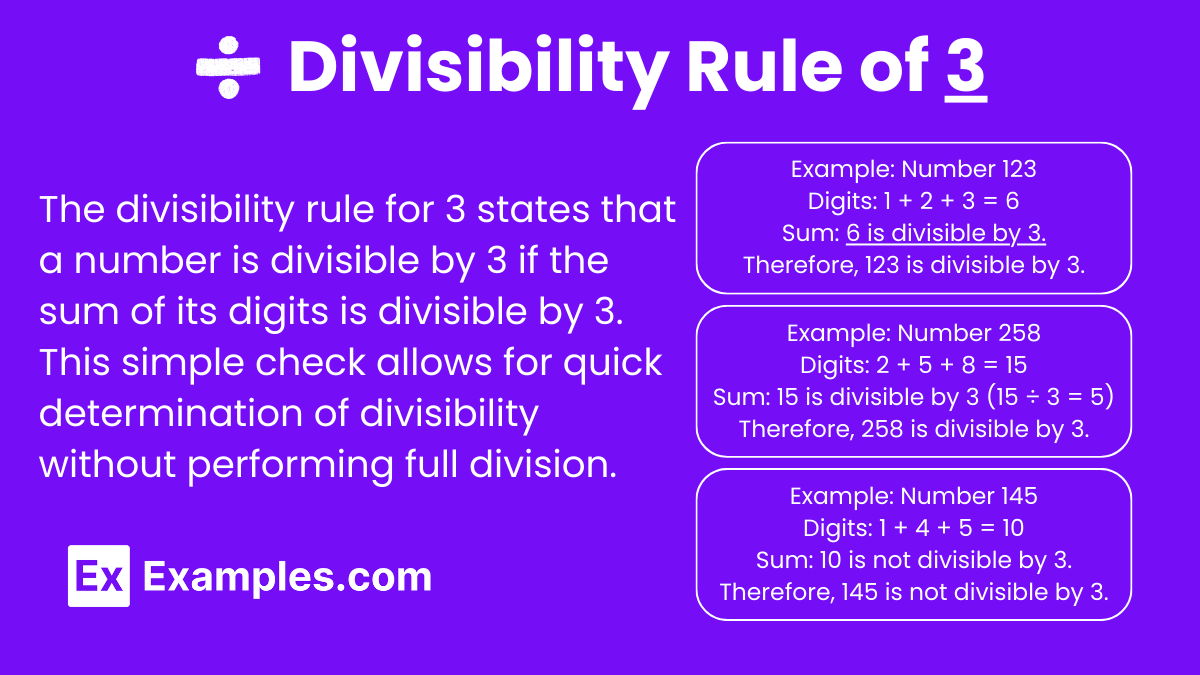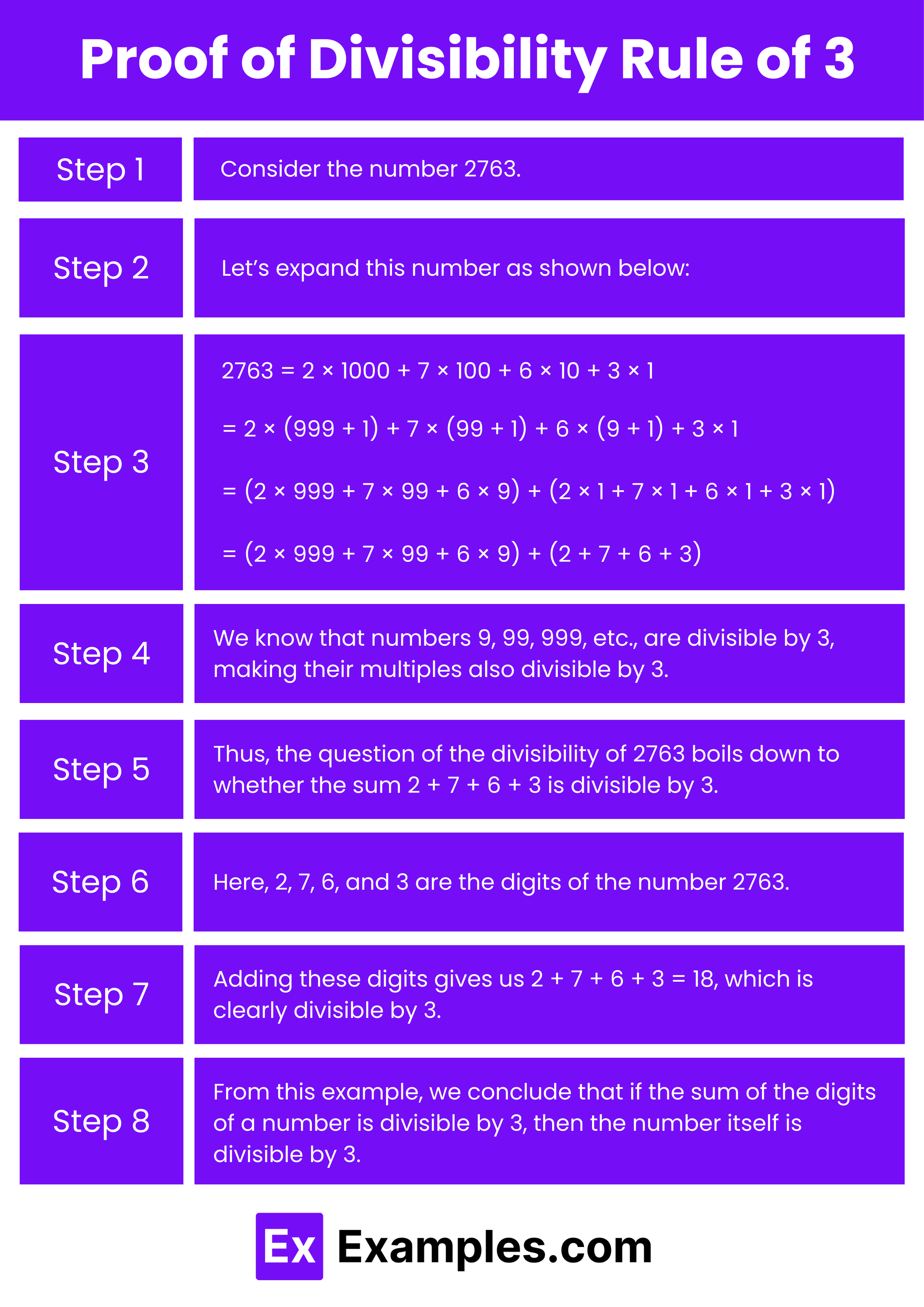Which of the following numbers is divisible by 3?
124
135
149
152


Divisibility rules, particularly for Numbers like 3, offer a quick way to determine if one number is divisible by another without extensive computation. This concept intersects various areas of mathematics including Algebra, where it assists in simplifying expressions, where it aids in data categorization. Understanding these rules enhances comprehension of broader mathematical concepts such as Integers, Rational and Irrational Numbers, Additionally, methods to utilize these fundamentals to optimize fits in data analysis, showcasing the pervasive application of basic arithmetic principles across advanced mathematical topics.
Download Proof of Divisibility Rule of 3 in PDF

Download Proof of Divisibility Rule of 3 in PDF
Let’s use the number 2763 to prove the divisibility rule of 3 with a similar step-by-step example.
Step 1: Consider the number 2763.
Step 2: Let’s expand this number as shown below:
Step 3: 2763 = 2 × 1000 + 7 × 100 + 6 × 10 + 3 × 1
= 2 × (999 + 1) + 7 × (99 + 1) + 6 × (9 + 1) + 3 × 1
= (2 × 999 + 7 × 99 + 6 × 9) + (2 × 1 + 7 × 1 + 6 × 1 + 3 × 1)
= (2 × 999 + 7 × 99 + 6 × 9) + (2 + 7 + 6 + 3)
Step 4: We know that numbers 9, 99, 999, etc., are divisible by 3, making their multiples also divisible by 3.
Step 5: Thus, the question of the divisibility of 2763 boils down to whether the sum 2 + 7 + 6 + 3 is divisible by 3.
Step 6: Here, 2, 7, 6, and 3 are the digits of the number 2763.
Step 7: Adding these digits gives us 2 + 7 + 6 + 3 = 18, which is clearly divisible by 3.
Step 8: From this example, we conclude that if the sum of the digits of a number is divisible by 3, then the number itself is divisible by 3.
The divisibility rule for 3 is straightforward: a number is divisible by 3 if the sum of its digits is divisible by 3. This rule is particularly useful because it simplifies the task of checking divisibility without performing actual division. For example, the number 621 is divisible by 3 since the sum of its digits (6 + 2 + 1 = 9) is divisible by 3.
Similarly, the divisibility rule for 9 is closely related to that of 3: a number is divisible by 9 if the sum of its digits is divisible by 9. This method checks for divisibility efficiently and quickly. For instance, consider the number 7386; adding its digits gives 7 + 3 + 8 + 6 = 24. Since 24 is not divisible by 9, 7386 is also not divisible by 9.
The divisibility test for 3 is simple: a number is divisible by 3 if the sum of its digits is divisible by 3. This test allows you to quickly determine whether a number can be divided by 3 without performing the division operation.
Add the digits: 2 + 7 + 6 = 15. Since 15 is divisible by 3, 276 is also divisible by 3.
Consider the number 214: 2 + 1 + 4 = 7. Since 7 is not divisible by 3, neither is 214.
Yes, the rule applies to any number, no matter how large, as long as you can sum its digits to check divisibility by 3.
Yes, it does. For instance, -123 has a digits sum of 1 + 2 + 3 = 6, which is divisible by 3, so -123 is divisible by 3.
It’s useful for simplifying fractions, checking if numbers are factors of larger numbers, and in division problems to avoid detailed calculations.
If the sum is large, continue to add the digits of the sum until you get a smaller number that can easily be evaluated for divisibility by 3.
No, the rule is universally applicable to all integers as long as the correct process of summing the digits and checking for divisibility is followed.
For the number 591, add the digits: 5 + 9 + 1 = 15. Since 15 is divisible by 3, so is 591.
Text prompt
Add Tone
10 Examples of Public speaking
20 Examples of Gas lighting
Which of the following numbers is divisible by 3?
124
135
149
152
Which of these numbers is not divisible by 3?
273
372
483
549
If a number is divisible by 3, which of these sums of its digits is also divisible by 3?
20
24
25
27
Which of these numbers is divisible by 3?
987
986
985
984
Find the number among these that is not divisible by 3.
1,566
1,575
1,584
1,593
Which of these numbers is divisible by 3?
2,457
2,468
2,479
2,480
Which of the following numbers is divisible by 3?
2,016
2,014
2,018
2,020
Which number is not divisible by 3?
3,543
3,555
3,567
3,579
Which of the following numbers is divisible by 3?
2,457
2,469
2,481
2,492
Which number is not divisible by 3?
5,832
5,849
5,856
5,873
Before you leave, take our quick quiz to enhance your learning!

